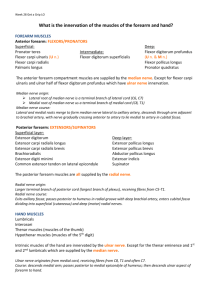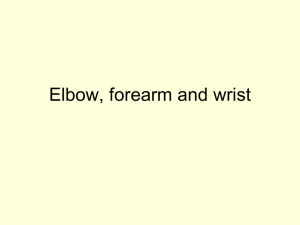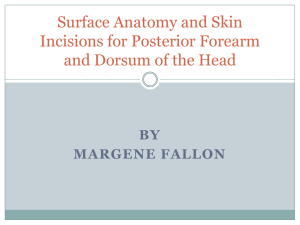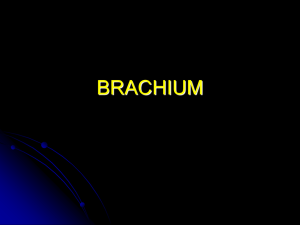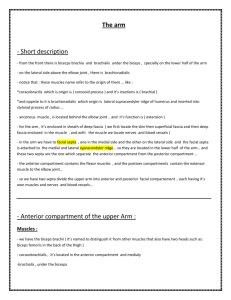File
advertisement
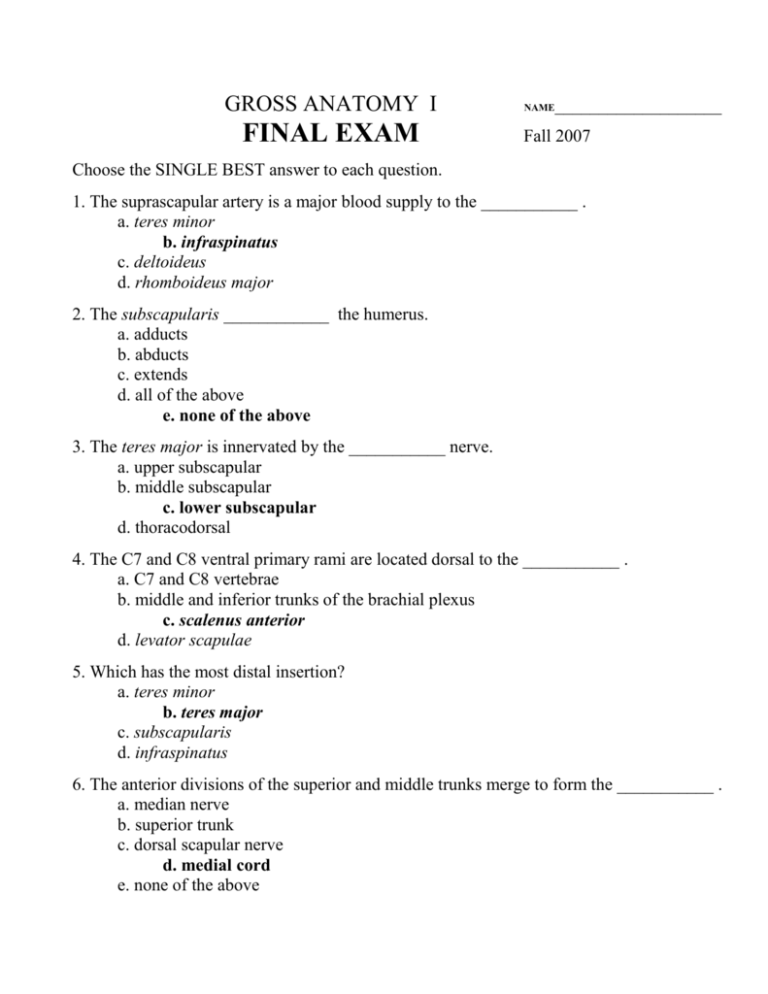
GROSS ANATOMY I FINAL EXAM NAME ___________________ Fall 2007 Choose the SINGLE BEST answer to each question. 1. The suprascapular artery is a major blood supply to the ___________ . a. teres minor b. infraspinatus c. deltoideus d. rhomboideus major 2. The subscapularis ____________ the humerus. a. adducts b. abducts c. extends d. all of the above e. none of the above 3. The teres major is innervated by the ___________ nerve. a. upper subscapular b. middle subscapular c. lower subscapular d. thoracodorsal 4. The C7 and C8 ventral primary rami are located dorsal to the ___________ . a. C7 and C8 vertebrae b. middle and inferior trunks of the brachial plexus c. scalenus anterior d. levator scapulae 5. Which has the most distal insertion? a. teres minor b. teres major c. subscapularis d. infraspinatus 6. The anterior divisions of the superior and middle trunks merge to form the ___________ . a. median nerve b. superior trunk c. dorsal scapular nerve d. medial cord e. none of the above 7. The axillary nerve reaches its destinations by passing through the ___________ . a. triangular interval b. deltopectoral triangle c. quadrangular space d. triangular space 8. The serratus anterior is innervated from the _______ level of the spinal cord. a. C5 b. C6 c. C7 d. all of the above 9. The middle branch off the brachial artery is the ___________ artery. a. deep brachial b. posterior humeral circumflex c. anterior ulnar recurrent d. superior ulnar collateral 10. Which of the following nerves innervates only a single muscle? a. axillary b. middle subscapular c. musculocutaneous d. suprascapular e. all of the above 11. None of the rotator cuff muscles ___________ the humerus. a. laterally rotate b. medially rotate c. adduct d. abduct 12. The breast is located completely within the ___________ fascia of the chest. a. superficial b. pectoral c. clavipectoral d. axillary 13. A ligament of Cooper might be mistaken for a(n) ___________ . a. nerve b. tendon c. lactiferous duct d. aponeurosis 14. The musculocutaneous nerve penetrates the ___________ . a. supinator b. biceps brachii c. coracobrachialis d. deltoideus 15. The levator scapulae and rhomboids are innervated from the ______ spinal cord level. a. C3 b. C4 c. C5 d. C6 e. C7 16. Which crosses the cubital fossa in the most lateral position? a. brachial artery b. tendon of the brachialis c. median nerve d. tendon of the biceps brachii 17. Which innervates some of the skin over the sternum? a. C8 VPR b. C8 DPR c. T6 VPR d. T6 DPR e. all of the above 18. Which nerve contributes to the C6 dermatome? a. lateral antebrachial cutaneous b. inferior lateral brachial cutaneous c. superior lateral brachial cutaneous d. all of the above e. none of the above 19. Which artery normally supplies blood to the brachialis? a. superior ulnar collateral b. middle collateral c. radial collateral d. interosseous recurrent 20. The ___________ gets some of its innervations from the ulnar nerve. a. pronator teres b. pronator quadratus c. flexor digitorum profundus d. flexor digitorum superficialis 21. The origin of the palmaris longus is the ___________ . a. lateral epicondyle b. medial epicondyle c. supracondylar ridge d. radial tuberosity 22. Pain down the whole thumb side of the arm, forearm, and hand could result from stretching the ___________ of the brachial plexus. a. superior trunk b. medial cord c. posterior cord d. C5 ventral primary ramus 23. The common interosseous artery is a branch of the ___________ artery. a. radial b. ulnar c. brachial d. anterior interosseous 24. The flexor retinaculum attaches to ____ bones . a. 1 b. 2 c. 4 d. 6 25. The tendon of the ___________ passes superficial to the flexor retinaculum. a. flexor digitorum superficialis b. flexor carpi radialis c. flexor carpi ulnaris d. palmaris longus e. all of the above 26. Which muscle is NOT innervated by the C8 level of the spinal cord? a. infraspinatus b. flexor carpi ulnaris c. adductor pollucis d. palmaris brevis 27. An axon that is part of the lateral antebrachial cutaneous nerve is also part of the ______ . a. medial cord b. musculocutaneous nerve c. inferior lateral brachial cutaneous nerve d. anterior division of the inferior trunk 28. The pectoralis minor is innervated by the ___________ nerve. a. long thoracic b. lateral pectoral c. medial pectoral d. thoracodorsal 29. Which muscle originates from the most bones? a. pectoralis major b. omohyoid c. serratus anterior d. pectoralis minor 30. The bicipital aponeurosis is deep to the ___________ . a. bicipital tendon b. median cubital vein c. median nerve d. brachial artery 31. The 5th distal interphalangeal joint is flexed by the ___________ . a. flexor digiti minimi b. flexor digitorum profundus c. flexor digitorum superficialis d. 4th lumbricales 32. Which originates from the lateral side of the 4th metacarpal? a. 3rd lumbricales b. 2nd dorsal interosseous c. 2nd palmar interosseous d. adductor pollucis 33. Most of the blood in the superficial palmar arch comes from the ___________ artery. a. radial b. ulnar c. anterior interosseous d. radialis indicis 34. The abductor pollucis longus is innervated by the ___________ nerve. a. superficial branch of the radial b. deep radial c. recurrent branch of the median d. posterior interosseous 35. Which tendon is found in the 2nd compartment of the extensor retinaculum? a. extensor pollucis longus b. extensor carpi radialis brevis c. extensor indicis d. abductor pollucis longus 36. Which originates from the lateral epicondyle of the humerus? a. anconeus b. brachioradialis c. extensor pollucis longus d. extensor carpi radialis longus 37. The _______________ ligament is part of the lateral collateral ligament of the ankle. a. posterior tibiotalar b. posterior tibiofibular c. calcaneofibular d. calcaneonavicular 38. Part of the ___________ ligament attaches to the medial side of the coronoid process. a. anular b. ulnar collateral c. radial collateral d. ligamentum capitis femoris 39. The ___________ ligament attaches only to the ulna. a. anular b. ulnar collateral c. radial collateral d. coracoclavicular 40. A small, but important branch of the obturator artery is carried by the ________ . a. trapezoid ligament b. ligamentum capitis femoris c. transverse ligament d. calcaneometatarsal ligament 41. Which neurotransmitter causes contraction of the smooth muscle in the walls of cutaneous arteries? a. epinephrine b. dopamine c. serotonin d. acetylcholine 42. Which ligament attaches to 2 different bones? a. anular b. coracoacromial c. anterior cruciate d. transverse humeral 43. Which muscle has 2 bellies, but only 1 head? a. biceps brachii b. triceps brachii c. omohyoid d. sternocleidomastoid 44. The ulnar nerve contributes to how many dermatomes? a. 1 b. 2 c. 3 d. 4 45. Which nerve is not derived from the radial nerve? a. posterior interosseous b. posterior brachial cutaneous c. superior lateral brachial cutaneous d. posterior antebrachial cutaneous 46. Consider a sympathetic axon that synapses with some stomach cells; where is that axon’s cell body located? a. sympathetic chain ganglion b. lateral horn c. celiac ganglion d. stomach wall 47. The 2nd branch off the 2nd part of the axillary artery is the ___________ artery. a. lateral thoracic b. subscapular c. anterior humeral circumflex d. scapular circumflex 48. Stretching the superior trunk of the brachial plexus could cause pain or numbness in the ___________ . a. medial forearm b. thumb c. medial arm d. digiti minimi 49. The coracobrachialis insertion is just opposite the insertion of the _______________ . a. teres major b. brachialis c. triceps brachii d. deltoideus 50. Which tendon can be palpated along the lateral border of the anatomical snuff box? a. abductor pollucis longus b. extensor pollucis longus c. extensor carpi radialis longus d. extensor carpi radialis brevis 51. The pectoral muscles, deltoid, and subclavius muscles all receive blood from the ______. a. lateral thoracic artery b. superior thoracic artery c. subscapular artery d. thoracoacromial trunk 52. The white rami communicantes are made up of _____________ . a. pre-ganglionic sympathetic axons b. pre-ganglionic parasympathetic axons c. post-ganglionic sympathetic axons d. post-ganglionic parasympathetic axons e. all of the above 53. The vagus nerve (cranial nerve X) is made up of _____________ . a. pre-ganglionic sympathetic axons b. pre-ganglionic parasympathetic axons c. post-ganglionic sympathetic axons d. post-ganglionic parasympathetic axons e. all of the above

